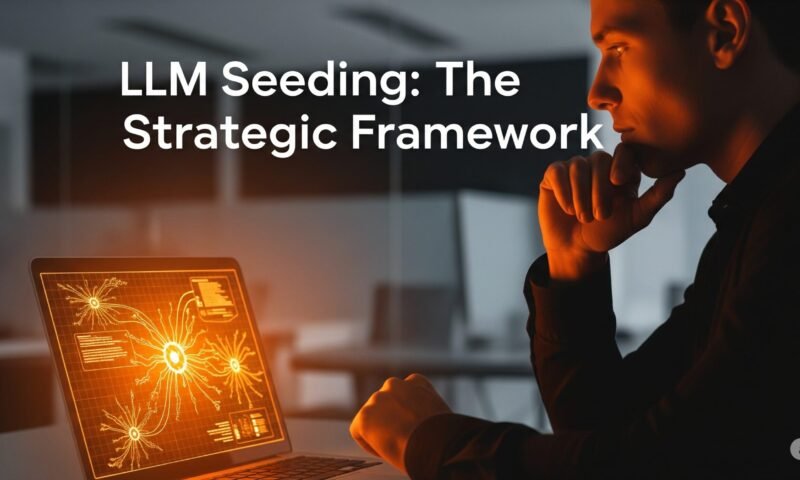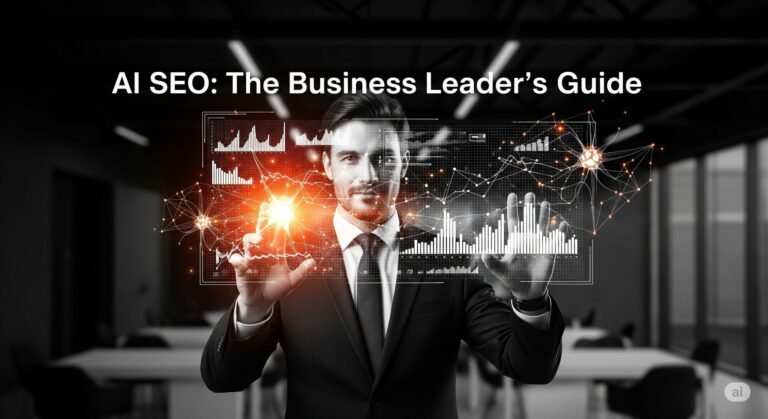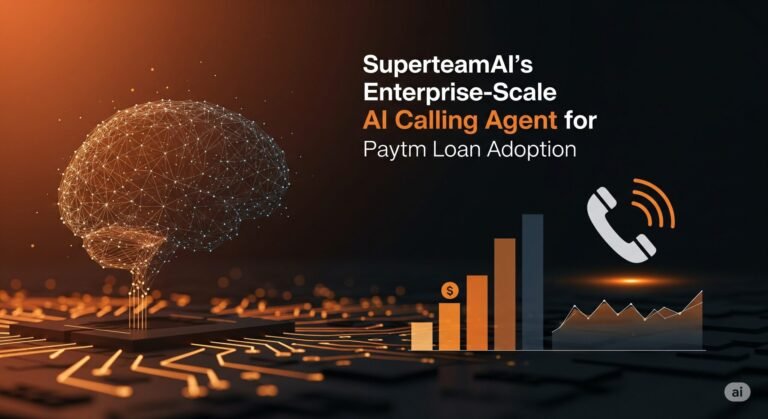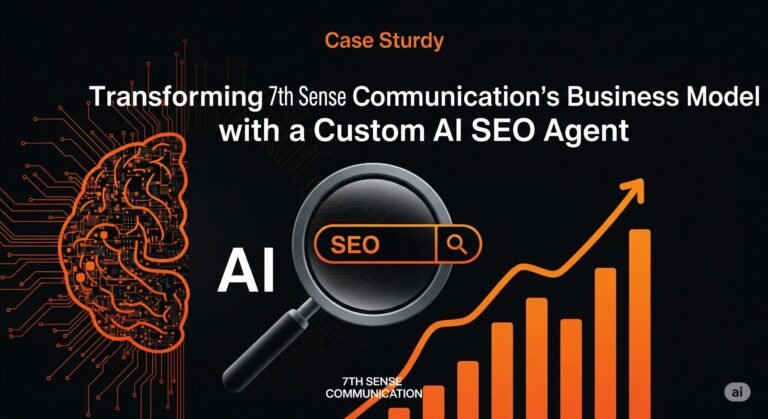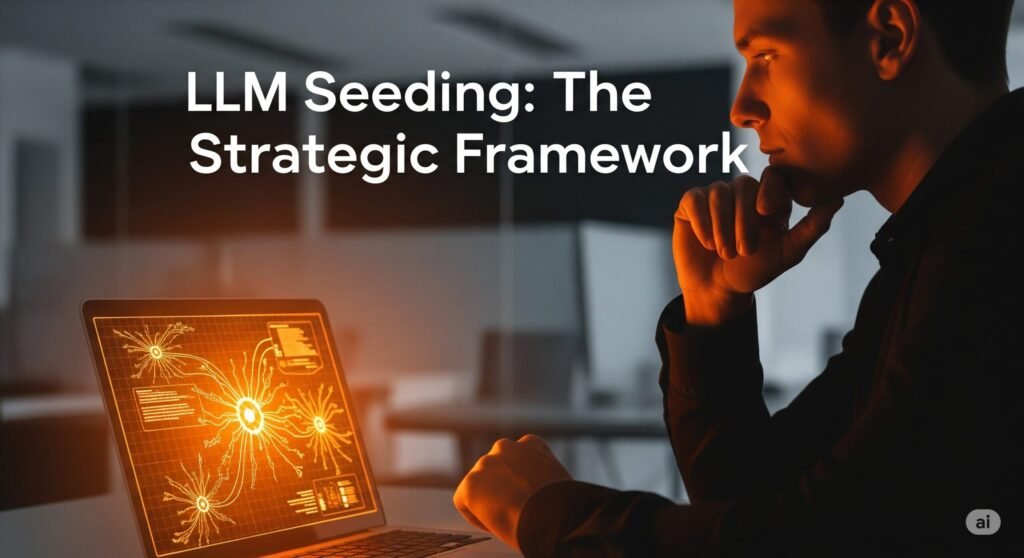
Introduction: The New Frontier of Brand Visibility
How AI is Reshaping Search and Brand Discovery
I remember when SEO was straightforward. Create great content, build backlinks, and watch your rankings climb. But those days are gone. Today, AI models like ChatGPT, Claude, and Perplexity are answering questions directly, bypassing traditional search results entirely.
According to recent data, AI search traffic will surpass traditional search by the end of 2027. This isn’t a distant future—it’s happening now. At SuperteamAI, we’ve seen this shift firsthand. Our own analytics show a 54% increase in impressions over three months, but a 15% decrease in clicks. This isn’t an anomaly; it’s the new reality.
The Rise of Zero-Click Searches and What It Means for Your Brand
Zero-click searches represent a fundamental challenge to traditional digital marketing. When users get their answers directly from AI, they don’t need to visit your website. The brands that thrive in this environment won’t be those with the #1 ranking, but those that get cited in the AI’s response.
I’ve personally witnessed businesses lose 30-40% of their organic traffic overnight as AI Overviews and similar features rolled out. The brands that survive and grow will be those that adapt quickly—optimizing not just for search engines, but for the AI models that are increasingly becoming the gatekeepers of information.
Introducing LLM Seeding: The Strategy You Need Now
This is where LLM seeding comes in. LLM seeding is the practice of publishing content in formats and places that large language models are most likely to scrape, summarize, and cite. It’s not about replacing your SEO efforts—it’s about complementing them with a strategy designed for the AI-powered future.
At SuperteamAI, we’ve been implementing LLM seeding strategies across our AI workforces, and we’ve seen remarkable results. We’re getting mentioned in AI responses even when we don’t rank #1 in traditional search. That’s the power of LLM seeding—it levels the playing field and creates new opportunities for brand visibility.
Understanding LLM Seeding: Beyond the Basics
What Exactly is LLM Seeding? (A Clear Definition)
LLM seeding is the strategic practice of creating and distributing content specifically designed to be cited by large language models. Unlike traditional SEO, which focuses on ranking in search results, LLM seeding focuses on becoming part of the AI’s response when users ask questions.
Think of it this way: traditional SEO is about getting users to click through to your website. LLM seeding is about getting your brand mentioned in the answer itself, even if there’s no click. It’s a fundamental shift from optimizing for clicks to optimizing for citations.
How LLMs Discover, Process, and Cite Content
LLMs are trained on vast amounts of data from across the internet. They don’t “see” websites the way humans do—they parse and process content based on structure, context, and relevance. When a user asks a question, the LLM searches its training data to find the most relevant information to include in its response.
What’s fascinating is that LLMs don’t just cite the top-ranking pages. In fact, nearly 90% of ChatGPT citations come from positions 21+ in traditional search results. This means your content on page 4 could get cited more than a competitor’s page 1 content—if it provides better answers in a format the AI can easily understand and extract.
The Fundamental Mindset Shift: From Clicks to Citations
This is where many marketers struggle. We’ve spent decades optimizing for clicks, conversions, and traffic. LLM seeding requires a different mindset—one focused on building brand awareness and authority rather than immediate traffic.
I had to make this shift myself when I noticed our organic traffic declining despite creating high-quality content. Once I started focusing on getting cited by AI models rather than just ranking in search, our brand visibility actually increased. We were getting mentioned in AI responses, which led to more branded searches and direct traffic over time.
The key is to understand that in an AI-powered world, brand mentions in AI responses are the new backlinks—they build authority and drive awareness, even without immediate clicks.
Why LLM Seeding Matters Now: Data and Trends
The Decline of Organic Traffic: By the Numbers
The data is clear: organic traffic is declining across the board as AI answers more queries directly. A recent study showed that websites are experiencing an average 15-20% drop in organic traffic due to AI Overviews and similar features.
At SuperteamAI, we analyzed our own traffic patterns and found that while our impressions increased by 54% over three months, clicks decreased by 15%. This pattern—growing impressions but declining clicks—is the signature of AI influence. Users see our brand mentioned in AI responses, make a mental note, and then search for us directly days or weeks later.
Projected Growth of AI Search: What the Data Shows
The shift to AI-powered search isn’t just a trend—it’s a fundamental transformation of how people find information. According to industry projections, AI search traffic will surpass traditional search by the end of 2027. That’s less than two years from now.
What does this mean for your business? If you’re not preparing for this shift now, you risk becoming invisible as more and more users turn to AI models for answers. The brands that establish themselves as trusted sources for LLMs today will be the ones that thrive in the AI-dominated search landscape of tomorrow.
Get Your Free AI SEO Agent
Transform your website’s performance with our powerful SEO AI agents. Complete setup guide included – no technical expertise required.
Case Study: How Brands Are Winning with LLM Seeding Today
Let me share a real example. A B2B SaaS company we worked with was struggling to generate leads despite ranking well for several key terms. When we analyzed their situation, we discovered they were getting very few mentions in AI responses.
We implemented an LLM seeding strategy focused on creating structured comparison content and distributing it on platforms that LLMs frequently cite. Within three months, they went from being mentioned in less than 5% of relevant AI responses to over 30%. More importantly, their direct traffic increased by 40%, and their lead quality improved significantly because the users coming to them were already primed by the AI’s recommendation.
This is the power of LLM seeding—it creates a new channel for brand visibility that complements traditional SEO and drives high-intent traffic.
The Strategic Framework for Authentic LLM Seeding
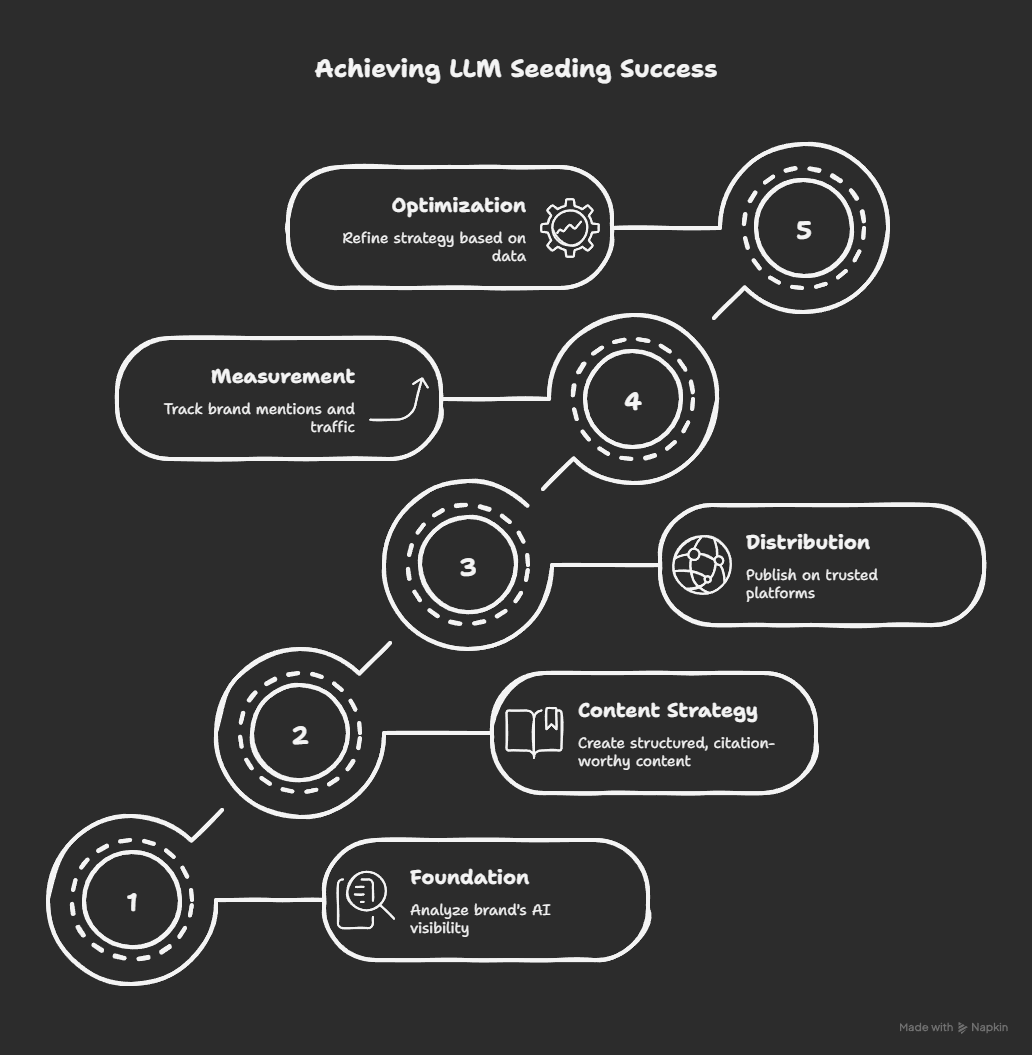
Phase 1: Foundation – Understanding Your Brand’s AI Opportunity
Before diving into content creation, you need to understand where your brand fits in the AI landscape. Start by analyzing how LLMs currently perceive your brand. Run manual prompts across different AI tools to see if and how you’re being mentioned.
At SuperteamAI, we begin by asking questions like:
- “What are the best [your product category] for [your target audience]?”
- “How does [your brand] compare to [competitors]?”
- “What are the alternatives to [competitor]?”
Document the results. Are you being mentioned? In what context? What’s the sentiment? This baseline analysis will help you understand your current AI visibility and identify opportunities for improvement.
Phase 2: Content Strategy – Creating Value That LLMs Want to Cite
Once you understand your current position, it’s time to create content that LLMs want to cite. The key is to focus on formats that align with how LLMs process information—structured, comprehensive, and authoritative content.
We’ve found that the most effective content for LLM seeding includes:
- Structured “best of” lists with clear selection criteria
- First-person reviews with detailed testing methodologies
- Comparison tables that highlight use cases and tradeoffs
- FAQ-style content that directly answers common questions
- Opinion-led pieces backed by expertise and data
The goal isn’t to create content solely for AI—it’s to create valuable content that serves both human readers and AI models. This balance is crucial for maintaining authenticity while optimizing for citations.
Phase 3: Distribution – Getting Your Content in Front of the Right AI
Creating great content is only half the battle. The other half is getting it in front of the right AI models. LLMs prioritize content from trusted sources, so distribution strategy is critical.
We focus on several key channels:
- Third-party platforms like Medium and LinkedIn that LLMs crawl frequently
- Industry publications where your expertise can lend credibility
- User-generated content hubs, especially Reddit (which LLMs cite more than any other source)
- Editorial-style microsites that build authority
- Review sites that influence AI recommendations
The key is to meet LLMs where they’re already looking for information. By distributing your content in these trusted environments, you increase the likelihood of being cited in AI responses.
Phase 4: Measurement – Tracking What Actually Matters
Measuring LLM seeding success requires different metrics than traditional SEO. While clicks and traffic are still important, you also need to track:
- Brand mentions in AI tools: Manually check how often your brand is mentioned in AI responses for relevant queries.
- Direct and branded search traffic: Look for increases in direct traffic and branded searches, which indicate that users are remembering your brand from AI mentions.
- Unlinked brand mentions: Monitor mentions of your brand across the web, even without links.
- Sentiment analysis: Track how your brand is positioned in AI responses—are you recommended as a budget option, premium choice, or innovative solution?
At SuperteamAI, we use specialized tools to track these metrics, but even manual monitoring can provide valuable insights into your LLM seeding performance.
Phase 5: Optimization – Refining Your Approach Based on Data
Like any marketing strategy, LLM seeding requires continuous optimization. Use the data from your measurement phase to refine your approach.
If you’re not getting mentioned in AI responses, analyze what is being cited. Is it the format? The platform? The content itself? Double down on what’s working and adjust what isn’t.
Remember that LLMs are constantly evolving, so your strategy needs to evolve too. Stay informed about changes in AI technology and adjust your approach accordingly.
Content That Gets Cited: Formats That Work (With Examples)
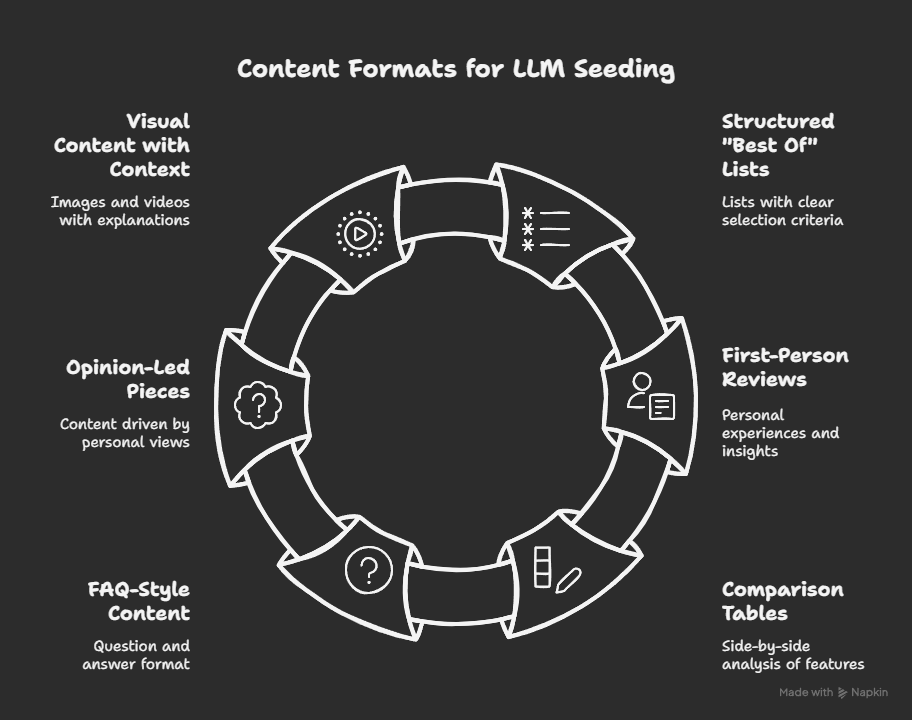
Structured “Best Of” Lists That Demonstrate Expertise
LLMs love structured “best of” lists because they provide clear, organized information that’s easy to extract and summarize. But not all lists are created equal.
To make your lists citation-worthy:
- Explain your selection criteria upfront
- Use targeted “best for” ratings that match search behavior
- Implement semantic chunking with clear, descriptive headings
- Add scoring systems or ratings based on specific criteria
For example, when we created our “Best AI Workforce Solutions” list, we included detailed information about our testing process, specific “best for” categories (like “Best for Small Teams” or “Best for Complex Workflows”), and a scoring system based on accuracy, cost-efficiency, and scalability. This structured approach made our content highly citeable by LLMs.
First-Person Reviews That Build Trust
Authentic, hands-on reviews are another format LLMs tend to favor because they demonstrate real expertise and experience.
To create effective first-person reviews:
- Include measurable outcomes and specific details
- Follow a repeatable testing process
- Use specific, quotable phrasing
- Include both positives and negatives for balance
When I reviewed AI workforce tools for my own business, I documented exactly how many tools I tested, my testing methodology, and specific results. This level of detail adds credibility and makes your review more likely to be cited by LLMs.
Comparison Tables That Answer Specific Questions
Mid-funnel users often turn to AI platforms to help make purchasing decisions, making comparison tables particularly effective for LLM seeding.
To create comparison tables that get cited:
- Include use-case verdicts (not just feature comparisons)
- Highlight tradeoffs for each option
- Use citation-ready phrasing that directly addresses user needs
Our comparison table of AI workforce solutions includes specific recommendations for different use cases, clear strengths and weaknesses for each option, and direct language that LLMs can easily quote when users ask which solution is best for their specific situation.
FAQ-Style Content That Matches LLM Training Data
LLMs are trained on Q&A content from platforms like Quora and Reddit, making FAQ-style content particularly effective for LLM seeding.
To create effective FAQ content:
- Structure questions as clear subheadings
- Write concise responses that start with direct answers
- Add structured data to help AI parse your content
- Cover both basic and advanced questions
When we created our FAQ on AI workforce implementation, we included questions ranging from “What is an AI workforce?” to “How do you measure ROI for AI automation?” This comprehensive approach made our content highly citeable for a wide range of user queries.
Opinion-Led Pieces That Showcase Unique Perspectives
Unique, well-supported opinions can make your content stand out to both human readers and LLMs.
To create effective opinion-led content:
- Back your opinions with expertise and evidence
- Structure your content clearly with defined sections
- Include actionable takeaways
- Add author credentials to establish authority
When I wrote about the future of AI in business operations, I included my personal experience implementing AI solutions, specific predictions backed by data, and clear recommendations for businesses. This combination of expertise and structure made the content highly citeable.
Visual Content With Context That AI Can Understand
Visual content keeps readers engaged, but it’s also another way to give LLMs more context about your content.
To make your visuals LLM-friendly:
- Write full-sentence captions that explain what’s pictured and why it matters
- Reference visuals directly in your copy
- Add alt text that reflects both the subject and its importance
- Use descriptive file names
When we include visuals in our content, we ensure they’re fully described in the surrounding text and include detailed captions and alt text. This approach helps LLMs understand and contextualize the visual elements.
Tools and Templates That Solve Real Problems
Offering valuable resources that solve real problems is another effective way to get cited by LLMs.
To create citation-worthy resources:
- Give your resource a clear, descriptive title that matches user search behavior
- Include an intro that explains who it’s for and how to use it
- Add supporting content to provide context
- Make the resource genuinely useful and easy to use
Our free AI ROI calculator, for example, includes a clear title, detailed instructions on how to use it, and supporting content about measuring AI implementation success. This comprehensive approach has made it one of our most-cited resources by LLMs.
Get Your Free AI SEO Agent
Transform your website’s performance with our powerful SEO AI agents. Complete setup guide included – no technical expertise required.
Industry-Specific LLM Seeding Strategies
LLM Seeding for B2B Companies: Establishing Authority in Niche Fields
B2B companies face unique challenges in LLM seeding because their audiences often have specific, technical questions. To succeed, focus on:
- Creating detailed comparison content that addresses specific use cases
- Developing industry-specific frameworks and methodologies
- Publishing in niche publications and forums where your target audience congregates
- Providing expert insights on industry trends and challenges
For B2B SaaS companies, we’ve found that creating comprehensive comparison guides and distributing them on platforms like LinkedIn and industry-specific forums has been particularly effective for LLM citations.
LLM Seeding for E-commerce: Getting Recommended in Product Searches
E-commerce brands need to focus on getting recommended in product-related queries. Strategies include:
- Creating detailed product reviews with specific use cases
- Developing comparison content that highlights your products’ unique advantages
- Encouraging customer reviews on platforms that LLMs frequently cite
- Creating visual content with detailed descriptions of product features and benefits
E-commerce brands we’ve worked with have seen success by creating detailed product roundups and distributing them on platforms like Pinterest and Instagram, where LLMs are increasingly looking for product information.
LLM Seeding for Service Businesses: Becoming the Go-To Recommendation
Service businesses need to establish themselves as experts in their field to get cited by LLMs. Effective strategies include:
- Creating FAQ content that addresses common customer questions
- Developing case studies that demonstrate specific results
- Publishing opinion-led content on industry trends and best practices
- Participating in relevant online communities and forums
Service businesses we’ve advised have seen success by creating comprehensive “how-to” guides and distributing them on platforms like Medium and industry-specific forums.
LLM Seeding for Content Creators: Building Personal Brand Through AI
Content creators and influencers can leverage LLM seeding to build their personal brand. Strategies include:
- Creating opinion-led content with unique perspectives
- Developing frameworks and methodologies that others can reference
- Participating in online discussions and forums related to your expertise
- Creating templates and resources that others can use
Content creators we’ve worked with have successfully increased their AI visibility by creating unique frameworks and distributing them on platforms like LinkedIn and Twitter, where they can engage directly with their audience.
Where to Seed Your Content for Maximum AI Pickup
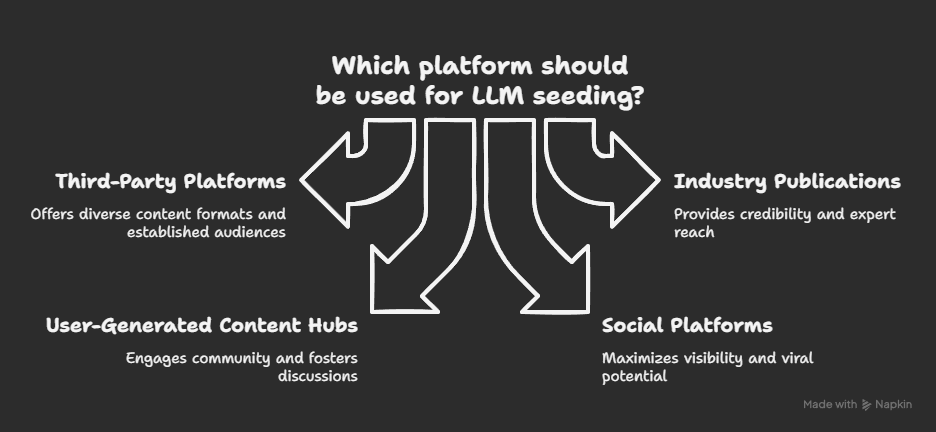
Third-Party Platforms That LLMs Trust
Certain third-party platforms are particularly effective for LLM seeding because their clean layout and consistent quality make them easy for AI to read and cite.
- Medium: Repurpose long-form content here, using section headers, summaries, and internal links for added context.
- Substack: Ideal for newsletter-style content and thought leadership commentary.
- LinkedIn articles: Indexed well and often tied to real profiles, giving your content a credibility bonus.
We’ve found that repurposing our most comprehensive guides on Medium and LinkedIn has significantly increased our citation rate in AI responses.
Industry Publications That Boost Credibility
LLMs are more likely to trust and cite content from respected industry sources. Strategies include:
- Guest posts: Focus on topics that align with popular LLM prompts, like product comparisons or how-tos.
- Expert quotes: Provide non-promotional, insight-driven quotes to increase your chances of being featured.
- Roundups: Pitch to writers creating “best of” lists, providing concise, structured blurbs with supporting context.
When we contribute expert quotes to industry publications, we make sure to provide specific, data-backed insights that add value to the conversation—not just promote our brand.
User-Generated Content Hubs (Especially Reddit)
LLMs cite Reddit more than any other source, making it a crucial platform for LLM seeding.
- Reddit: Participate in relevant subreddits where you can highlight your expertise and add genuine value.
- Quora: Provide comprehensive answers to industry questions with clear structure.
- GitHub Discussions: For technical brands, participate in community discussions beyond your product.
- Niche Forums: Contribute regularly to specialized communities with meaningful, non-promotional input.
We’ve made Reddit a core part of our LLM seeding strategy, regularly participating in discussions related to AI and business automation. This consistent presence has significantly increased our citation rate.
Editorial-Style Microsites That Build Authority
Editorial-style microsites tend to carry more credibility than heavily branded company pages because they’re structured like independent publications.
- Create a trusted, well-organized resource that covers your entire industry, not just your product.
- Focus on E-E-A-T signals: include author bios with credentials, cite reputable sources, and make editorial policies easy to find.
- Clearly state who’s behind the site and why it exists.
While we haven’t implemented this strategy yet at SuperteamAI, we’ve seen other brands successfully use microsites to establish authority and increase their LLM citation rate.
Review Sites That Influence AI Recommendations
Content from review platforms is often cited in LLMs because they follow a formula that attracts AI attention: feature breakdowns + pros & cons + user reviews.
- Encourage customers to leave honest, detailed reviews.
- Prompt them with specific questions about their experience.
- Follow up with power users and long-term customers.
We actively encourage our customers to leave detailed reviews on platforms like G2 and Capterra, providing specific prompts to help them share their experiences. These detailed reviews have increased our visibility in AI responses.
Social Platforms That LLMs Monitor
Social platforms are increasingly important for LLM seeding, but some are more effective than others.
- X: Educational threads tend to perform better than quick takes. Focus on multi-post insights.
- YouTube: Include descriptive titles, detailed descriptions, and accurate captions.
- Pinterest: Ideal for visual brands—include rich descriptions and link to structured content.
- Instagram: Add captions, alt text, and hashtags to help shape how your brand appears in AI platforms.
We’ve found that creating educational threads on X and detailed videos on YouTube has been particularly effective for increasing our AI visibility.
Get Your Free AI SEO Agent
Transform your website’s performance with our powerful SEO AI agents. Complete setup guide included – no technical expertise required.
Balancing AI Optimization With Human Value
Maintaining Brand Voice While Optimizing for AI
One of the biggest challenges of LLM seeding is maintaining your brand voice while optimizing for AI. The key is to focus on creating content that serves both human readers and AI models.
At SuperteamAI, we’ve developed a framework that balances AI optimization with human-centric content:
- Start with your brand voice and values
- Structure content in AI-friendly formats
- Ensure the content provides genuine value to human readers
- Optimize technical elements (like headings and structure) for AI
This approach ensures that our content remains authentic to our brand while still being optimized for LLM citations.
Creating Content That Serves Both Humans and LLMs
The most effective LLM seeding strategy creates content that serves both human readers and AI models. This means:
- Focusing on providing genuine value and solving real problems
- Structuring content in ways that are easy for both humans and AI to understand
- Including specific examples and data that support your points
- Making content skimmable and scannable for human readers while maintaining the structure AI needs
When we create content, we always ask: “Would this be valuable to our target audience?” and “Is this structured in a way that AI can easily extract and cite?” This dual focus ensures our content works on both levels.
Avoiding the Trap of Creating Content Solely for Machines
It’s tempting to focus solely on optimizing for AI, but this approach ultimately backfires. Content created solely for machines lacks the authenticity and value that both human readers and AI models prioritize.
To avoid this trap:
- Always prioritize providing genuine value to your audience
- Maintain your brand voice and perspective
- Focus on solving real problems, not just gaming the system
- Remember that AI models are trained to prioritize high-quality, valuable content
At SuperteamAI, we’ve seen that the content that performs best with LLMs is also the content that resonates most strongly with our human audience. This isn’t a coincidence—AI models are designed to prioritize valuable, authoritative content.
The Ethics of LLM Seeding: Staying Authentic and Transparent
As with any marketing strategy, ethics matter in LLM seeding. The goal is to make your valuable content more discoverable by AI models, not to manipulate the system.
Key ethical considerations:
- Always provide accurate, truthful information
- Clearly disclose any affiliations or sponsored content
- Focus on adding genuine value, not just gaming the system
- Respect the platforms where you distribute your content
We believe that ethical LLM seeding not only aligns with our values but also delivers better long-term results. Authentic, valuable content builds trust with both human readers and AI models.
Measuring LLM Seeding Success: Metrics That Matter
Tracking Brand Mentions Across AI Platforms
The most direct way to measure LLM seeding success is to track how often your brand is mentioned in AI responses.
- Run manual prompts across different AI tools (ChatGPT, Claude, Perplexity, etc.)
- Use a private browser to avoid skewed results from past queries
- Search the way your audience would—naturally and with clear intent
- Document the sentiment and context of each mention
We track these mentions monthly, documenting which AI tools mention us, what prompts trigger mentions, and how we’re positioned in the response. This data helps us understand our AI visibility and identify opportunities for improvement.
Analyzing Direct and Branded Search Traffic
While LLM seeding focuses on citations rather than clicks, it often leads to increased direct and branded search traffic over time.
- Monitor direct traffic trends in Google Analytics
- Compare with organic traffic changes in Google Search Console
- Look for the signature pattern of LLM influence: declining clicks + growing direct traffic
We’ve seen this pattern in our own analytics—while organic clicks have decreased, direct traffic has increased as users remember our brand from AI mentions and search for us directly later.
Monitoring Unlinked Brand Mentions
Not every brand mention includes a link, making these mentions harder to track but no less valuable.
- Use tools like Semrush Brand Monitoring, SparkToro, or Google Alerts
- Set up alerts for your brand name, product names, and key team members
- Analyze the context of mentions—are you being cited as an expert? Recommended as a tool?
We monitor these mentions closely, as they’re strong indicators of our brand’s authority and influence. They also provide opportunities for engagement and relationship building.
Using Specialized Tools for LLM Visibility Tracking
As LLM seeding has grown in importance, specialized tools have emerged to help track performance.
- Tools like Semrush’s Enterprise AIO can track how your brand is perceived and cited in popular AI platforms
- These tools provide insights into market share, sentiment, and consumer engagement across AI platforms
- They can also track performance across individual AI models
We use these tools to get a comprehensive view of our LLM visibility, tracking our performance across different AI platforms and comparing it to competitors.
Setting Realistic KPIs and Timelines
LLM seeding is a long-term strategy, and it’s important to set realistic expectations.
- Initial results may take 3-6 months to materialize
- Focus on trends over time rather than day-to-day fluctuations
- Set specific, measurable goals for brand mentions, direct traffic, and sentiment
- Regularly review and adjust your strategy based on performance data
We’ve found that patience and consistency are key to LLM seeding success. It’s not about overnight results but about building sustainable visibility in an AI-powered world.
The Future of LLM Seeding: Staying Ahead as AI Evolves
How LLM Technology Is Changing and What It Means for Your Strategy
LLM technology is evolving rapidly, with new models and capabilities emerging regularly. These changes will impact LLM seeding strategies.
- Models are becoming more sophisticated in how they evaluate and cite sources
- Integration with real-time data is improving, making freshness more important
- Multimodal capabilities are expanding, allowing LLMs to process and cite visual content
- Personalization is increasing, potentially leading to more tailored responses
At SuperteamAI, we’re constantly monitoring these developments and adjusting our strategies accordingly. The key is to stay informed and flexible, ready to adapt as the technology evolves.
Emerging Trends in AI Search and Discovery
Several trends are shaping the future of AI search and discovery:
- Voice search is becoming more prevalent, changing how queries are phrased
- Visual search is improving, allowing users to search with images rather than text
- Conversational search is gaining traction, with users expecting more natural, dialogue-based interactions
- Personalized results are becoming more common, with AI tailoring responses to individual users
We’re adapting our LLM seeding strategies to account for these trends, creating content that works across different search modalities and serves diverse user needs.
Preparing Your Brand for the Next Wave of AI Innovation
To stay ahead of the curve, brands need to prepare for the next wave of AI innovation:
- Invest in understanding AI technology and how it’s evolving
- Build a flexible content strategy that can adapt to changing AI capabilities
- Focus on creating genuinely valuable content that will remain relevant regardless of technological changes
- Develop a diverse distribution strategy that reaches users across multiple platforms and touchpoints
At SuperteamAI, we’re constantly experimenting with new approaches and technologies, ensuring we’re prepared for whatever comes next in the rapidly evolving AI landscape.
Integrating LLM Seeding With Your Broader Marketing Strategy
LLM seeding shouldn’t exist in isolation—it should be integrated with your broader marketing strategy.
- Align LLM seeding with your brand positioning and messaging
- Coordinate with your SEO, content marketing, and PR efforts
- Ensure consistency across all channels and touchpoints
- Measure the impact of LLM seeding on overall marketing performance
We’ve found that LLM seeding works best when it’s part of a cohesive, integrated marketing strategy that reinforces our brand message across multiple channels.
Getting Started: Your LLM Seeding Action Plan
Step 1: Audit Your Existing Content for AI-Friendliness
Before creating new content, audit what you already have:
- Review your top-performing content for AI-friendly elements
- Identify content that’s already being cited by LLMs
- Look for opportunities to improve existing content with better structure and formatting
- Prioritize content that addresses common questions in your industry
We regularly audit our content library, identifying pieces that can be optimized for LLM seeding and updating them with better structure, more comprehensive information, and clearer formatting.
Step 2: Identify Your Biggest LLM Seeding Opportunities
Based on your audit and research, identify where to focus your efforts:
- Analyze which topics and formats are most frequently cited in your industry
- Identify gaps in existing content that you can fill
- Determine which platforms are most effective for your target audience
- Prioritize opportunities based on potential impact and resource requirements
We use a combination of manual research and tools to identify our biggest opportunities, focusing on areas where we can provide unique value and where LLMs are actively seeking information.
Get Your Free AI SEO Agent
Transform your website’s performance with our powerful SEO AI agents. Complete setup guide included – no technical expertise required.
Step 3: Create Your First LLM-Optimized Piece of Content
Start with something manageable but impactful:
- Choose a format that aligns with your strengths and audience needs
- Focus on providing genuine value, not just optimizing for AI
- Structure your content with clear headings and logical organization
- Include specific examples, data, and actionable insights
When we create new content, we always start with a clear understanding of our audience’s needs and how we can provide unique value. The AI optimization comes second—first and foremost, the content must be genuinely useful.
Step 4: Implement Your Distribution Strategy
Creating great content is only half the battle—distribution is equally important:
- Identify the platforms where your target audience and LLMs converge
- Tailor your content for each platform while maintaining your core message
- Engage with communities and build relationships over time
- Monitor performance and adjust your approach based on results
We’ve found that a consistent, sustained presence on key platforms is more effective than sporadic, high-effort campaigns. Building relationships and providing value over time leads to better results.
Step 5: Measure, Learn, and Iterate
LLM seeding is an ongoing process of improvement:
- Track your performance using the metrics outlined earlier
- Analyze what’s working and what isn’t
- Experiment with new approaches and formats
- Continuously refine your strategy based on data and results
We’re always testing new approaches and measuring their impact, using what we learn to improve our LLM seeding strategy over time. This iterative approach has been key to our success.
Conclusion: Building Brand Value in the Age of AI
Key Takeaways for Effective LLM Seeding
LLM seeding represents a fundamental shift in how brands build visibility and authority in an AI-powered world. The key takeaways are:
- Focus on creating valuable, structured content that serves both human readers and AI models
- Distribute your content on platforms that LLMs trust and frequently crawl
- Measure success through brand mentions, direct traffic, and sentiment—not just clicks
- Balance AI optimization with authentic, human-centric content
- Stay flexible and adapt as AI technology continues to evolve
The Long-Term Benefits of a Balanced Approach
When implemented effectively, LLM seeding delivers significant long-term benefits:
- Increased brand visibility and authority, even as traditional search evolves
- More consistent traffic and leads, less dependent on algorithm changes
- Stronger brand positioning as a trusted source in your industry
- Better alignment with how users are actually finding information in an AI-powered world
At SuperteamAI, we’ve seen these benefits firsthand. LLM seeding has become a core part of our marketing strategy, complementing our traditional SEO efforts and helping us build sustainable visibility in a rapidly changing landscape.
Final Thoughts: Making AI Work for Your Brand, Not Against It
The rise of AI-powered search isn’t a threat—it’s an opportunity. By embracing LLM seeding and focusing on creating genuinely valuable content, you can build brand visibility and authority that will endure regardless of how search technology evolves.
The key is to balance AI optimization with authentic, human-centric content. Don’t create content solely for machines—create content that serves your audience first and foremost. The AI citations will follow naturally.
At SuperteamAI, our mission is to democratize access to high-quality, specialized labor through AI automation. LLM seeding is an extension of that mission—helping businesses of all sizes build visibility and authority in an AI-powered world.
The future of search is here, and it’s powered by AI. The question is: will you be part of the conversation?
Frequently Asked Questions About LLM Seeding
How long does it take to see results from LLM seeding?
LLM seeding is a long-term strategy, and results typically take 3-6 months to materialize. Initial improvements in AI mentions may appear sooner, but significant increases in brand visibility and traffic usually require consistent effort over several months. The timeline can vary based on your industry, the quality of your content, and how effectively you distribute it.
Is LLM seeding replacing traditional SEO?
LLM seeding isn’t replacing traditional SEO—it’s complementing it. Traditional SEO focuses on ranking in search results, while LLM seeding focuses on getting cited in AI responses. The most effective strategies combine both approaches, creating content that performs well in traditional search while also being optimized for AI citations.
How much budget should I allocate to LLM seeding?
The budget for LLM seeding depends on your goals, industry, and current resources. For most businesses, we recommend starting with a modest allocation—perhaps 10-15% of your content marketing budget—and scaling based on results. Remember that LLM seeding relies more on strategic content creation and distribution than on paid advertising, so it can be relatively cost-effective compared to other marketing strategies.
Can small brands compete with larger ones in LLM seeding?
Absolutely! One of the advantages of LLM seeding is that it levels the playing field. Unlike traditional search, where larger brands often dominate the top positions, LLMs prioritize the best answers regardless of the source. Nearly 90% of ChatGPT citations come from positions 21+ in traditional search results, meaning smaller brands with high-quality, well-structured content can outperform larger competitors in AI responses.
How often should I update your LLM seeding strategy?
LLM seeding should be reviewed and updated quarterly, with more significant revisions annually. AI technology is evolving rapidly, and what works today may not be as effective six months from now. Regular reviews allow you to stay current with technological changes, adjust your strategy based on performance data, and continuously improve your results.
Get Your Free AI SEO Agent
Transform your website’s performance with our powerful SEO AI agents. Complete setup guide included – no technical expertise required.
